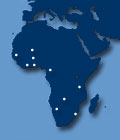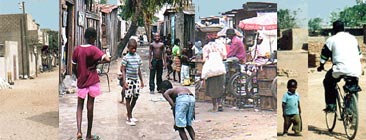|
||||||||||||
| Burkina Faso | Cameroon | Cote D’Ivoire | Ghana | Mali | Namibia | Senegal | Swaziland | Tanzania | Zambia | ||||||||||||
|
|
||||||||||||
|
||||||||||||
| Introduction
In the World Bank’s first decade of urban sector lending (1972-82), one of the primary areas of intervention was the provision and improvement of housing for the urban poor. The urban sector supported discrete projects with an emphasis on affordability, cost recovery and replicability. In contrast to the era of slum clearance by national governments in the 1960s, the rise of the influential self-help paradigm in housing projects during the 1970s and 1980s was based on two types of approaches: the provision of sites and services, and in-situ slum upgrading. During this time, the Bank financed 50 urban sector loans in 35 countries, with sites and services and in-situ upgrading absorbing almost 60 percent of its allocations. By the mid-1980s, this particular project approach to housing and urban development had met with serious criticism from both within and outside of the Bank. • At the micro-level, criticism was leveled at the inefficiencies created by individual projects. Such critiques included:
• At the macro-level, critiques centered on the lack of an overarching institutional framework and the concomitant need for a programmatic approach to urban lending. Such macro critiques led to a wave of policy prescriptions in the late 1980s and the 1990s which focused instead on establishing efficient property markets, setting appropriate regulations and standards, decentralizing authority to local governments, and building local capacity. Some lessons from the micro critiques were incorporated. But the macro critiques caused a substantial shift to a new generation of urban operations focused on programmatic lending and citywide development strategies with a long-term perspective. Evaluations of past upgrading projects are not entirely negative. Many studies found that the first generation of urban projects had a significant impact on the housing stock and the lives of the urban poor. They can hardly have been deemed a failure. It is time to rethink the past experience with upgrading. The next challenge will be to integrate a project approach to planning at the neighborhood scale with the supply-side local government and institutional framework of the 1990s. Approaches must revive many of the original intentions that lay behind upgrading projects while emphasizing the importance of institutional capacity building. While a great deal of evaluation research has been conducted in Latin America and Asia, Sub-Saharan Africa has received much less attention. The Bank shifted its primary urban focus from upgrading to strengthening local governments, but many other donors and national governments continued to prepare upgrading projects in Africa. This 10-country assessment attempts to highlight positive and negative lessons learnt in readdressing urban issues in Africa. Overview of Conclusions What should upgrading programs include?
How should upgrading programs be financed?
Who should do what?
How to scale-up: unresolved issues, challenges and next steps
|
||||||||||||
|
|
||||||||||||
| For more information: See full paper below or click on: Background to Study 1. Introduction 2. Goals of Upgrading 3. Policy Approaches 4. Social Issues 5. Physical Issues 6. Financial Issues 7. Institutional Issues 8. Directions for Future Research Download for Printing: full paper “Urban Upgrading in Africa: A Summary of Rapid Assessments in Ten Countries” (June 2002) (Acrobat PDF file, 88 k) Overview presentation, download: "Experience with Urban Upgrading in Africa", (PowerPoint file, 80K) Country Assessments: Burkina Faso, Cameroon, Cote D'Ivoire, Ghana, Mali, Namibia, Senegal, Swaziland, Tanzania, Zambia |
||||||||||||
| < Return to top > | ||||||||||||
|
||||||||||||


